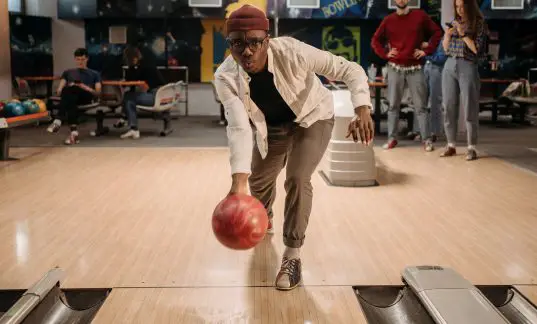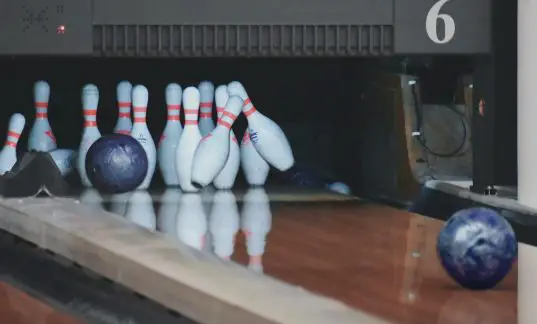Are you struggling to maintain a comfortable grip on your bowling ball when approaching a bowling lane? Are you experiencing pain or discomfort in your dominant hand when using house balls at your local bowling alley?
Do you need more control over your shot and are you looking for grip styles to help you accomplish that?
We’ve created this guide on how to hold a bowling ball for casual bowlers, intermediate bowlers, and advanced bowlers alike — a crash course and/or refresher on the proper way to hold and throw a bowling ball.
Most bowlers might feel confident that they’re holding a bowling ball correctly. But, one false move (or grip) at your release point could lead to pain or serious injury. Why not get your grip down perfectly, adding to your pin carry while decreasing your chances of a hospital trip?
Let’s get started.
How do you hold a bowling ball properly?
How many holes does a common bowling ball have? Three holes — one for the thumb, one for the middle finger, and one for your ring finger.
To properly hold a ball with a conventional grip, place the thumb of your bowling hand in the larger bottom hole. Your ring and middle fingers will go in the two adjacent holes above. Place all three fingers down to the second knuckle joint to get a solid grip. (You can go down to the first knuckle if you want more hook, but we’ll talk about that later.)
Use your index finger and your non-dominant hand to brace the ball as you hold it. This prevents injuries to your thumb and the other two fingers in the side-by-side holes. Try to keep your grip loose enough to fit a straw between your hand and the ball, but tight enough to maintain control. This common grip will lead to more strikes for beginners and the most control for those just learning the game.
Which fingers go in the bowling ball?
As we stated before, your thumb, middle, and ring fingers should be placed in the bowling ball for a conventional grip. However, other grips might eschew thumb releases or change your finger placement for more hook potential. Many bowlers only know the common grip with the fingers fully inserted. However, there are other ways to hold a bowling ball that can help intermediate bowlers and experts get an edge over the competition.
What is a fingertip grip and how does it differ from a conventional grip? A semi-fingertip grip?
A fingertip grip lessens the depth of a bowling ball’s finger holes, allowing a bowler to insert their fingers to the first knuckle and the first knuckle only. A fingertip grip, especially when coupled with a reactive ball, increases your ball’s engagement with the lane and its oil pattern. This allows you to generate more friction than a conventional grip, opening up the angles with which you can approach the pins. The more friction and angularity you can create, the sharper the hook you can pull off to and through the pins.
A semi-fingertip grip is a good compromise for those bowlers who want to add a hook without losing control. With this grip, you insert your thumb to the full second knuckle while only inserting your middle and ring fingers to the point between the first and second knuckle joint. With this grip, you can add angularity and friction without things getting too wonky and hard to tame.
How should a beginner hold the ball?
We recommend a conventional grip for beginners. When you place your thumb, middle and ring finger down to the second knuckle and brace the ball with your other hand, you can maintain maximum stability and control during your swing. Until you get your mechanics down and find your groove as a bowler, a conventional grip is a good safety measure to find the pins and do so in a manner that doesn’t risk injury.
How do professional bowlers hold bowling balls?
It depends on the pro bowler. Some bowlers use a fingertip grip for maximum hook potential. Others use a semi-fingertip grip for a little more reliability and a little less wildness. Some use a variation of a conventional grip or a straight conventional grip, especially when picking up spares.
Pro bowlers are always looking for an edge. So, you may see a pro change their grips as time goes on in hopes of maximizing their strike potential and minimizing their mistakes.
6 Tips For Holding A Bowling Ball Correctly
1) Don’t put undue stress on your middle and ring fingers with a house ball.
If the finger holes just aren’t working on the house ball you’ve picked, look for another house ball. There’s no reason to hurt your fingers or arm with a ball that’s just not calibrated for your swing or hand size. Most of the stress will be placed on your middle and ring fingers, so pay attention to how they feel as your day or night at the lanes goes on. Don’t be afraid to try different house balls to find the right feel.
2) The difference between the first and second knuckle is huge.
It may be only an inch or so in length, but the space between your first and second knuckles is critical to controlling a ball and/or hooking it. The deeper your fingers are in a bowling ball, the less hook you can generate with a traditional handshake position release. The closer to the first knuckle you get on a grip, the more friction, and angularity you can play with. Check it out the next time you play. Your hooks will be much smoother and more muted with a deep conventional grip, compared to a fingertip grip or semi-fingertip grip.
3) Conventional grips and finger holes might work best for recreational bowlers, but not for some more experienced bowlers.
It all depends on what you need out of a throw. Some expert bowlers use a conventional grip for straight-line spares and a fingertip grip for everything else. That’s because they want a sharper, more sideways hook to create more violent pin action after impact.
Yes, a conventional grip offers more straight-line ball speed and pinpoint accuracy. But, it cuts into your ability to change your entry angles from the breakpoint — lessening the overall effectiveness of a hook for some advanced bowlers.
4) Need to throw a straight ball? A conventional bowling grip is a good way to go.
As we said before, straight ball throwing is best with a conventional grip. That’s because you are lessening the variable of friction when you slot a ball into the middle of the lane. It also works best with a straight ball arm swing, offering more control and a more dependable release over and over again.
5) Struggling to generate hook when you insert your thumb in the thumb hole? Consider an interchangeable thumb slug.
Is your thumb dropping too deeply into your ball to get the hook you want? An interchangeable thumb slug might be able to help! This will help you turn a conventionally-drilled bowling ball into a fingertip grip beast without spending money on a new ball or a pro shop adjustment.
6) Pay just as much attention to your arm swing as your finger placement.
Your finger placement is crucial to holding a bowling ball. But, your arm swing is just as crucial to turning that grip into spares and strikes on the other end. If your grip is fine but your swing is out of whack, you’re going to struggle to do much of everything. Treat your body like a well-oiled machine and pay attention when a cog or two are loose. Your shot and scores will be better for it.

